We Won a Small Victory – Now Come Take Advantage of It
 This is why citizen participation matters.
This is why citizen participation matters.
Last week, local officials were balking at reserving a slot at next Thursday's regional air planning meeting for a presentation by UNT researchers on how gas industry emissions from the Barnett Shale could be adding to DFW's chronic smog.
After reading about the UNT research in the Denton Record Chronicle, Downwinders at Risk and State Representative Lon Burnam specifically asked the local Council of Governments to include the UNT work on the agenda.
At first, we were told that there was already one technical presentation scheduled for the meeting and there wouldn't be any time for a second.
That struck us as strange, since in the past, every such meeting has always had more than one technical presentation.
When we pointed this out in an e-mail with links to past meeting agendas to prove the point, we quickly got a different response. Suddenly, there would be time for the UNT presentation.
That wasn't so hard was it? All it took was a little logical push back. But if we hadn't supplied it, Thursday would be looking a lot different.
Now, we're asking you to please come and help us push back a little more.
State environmental officials are on record as saying the air pollution from gas mining and production in the Barnett Shale is not adding to DFW's smog.
A lot of us think otherwise.
Come next Thursday, on the 17th, you can listen to the new UNT research on fracking air pollution and ask Texas Commission on Environmental Quality officials directly what makes them so sure that gas pollution isn't hurting local air quality.
Because the format of these regional clean air meetings are now so informal, anyone in the audience can ask questions of a presenter. That means you – if you show up.
It doesn't matter if you don't know the technical lingo. This is all about wind direction, weather, and things that pollute. There are no stupid questions.
The new anti-smog plan that the state is building needs all the public scrutiny it can get. It needs tough examination by people who care about clean air and the truth.
Next Thursday, you can help us put the state on the spot.
This is the first opportunity in 2014 to speak up and sound off about our decades-long smog problem. Don't let the TCEQ leave town without hearing from you.
We fought and won the right for you to listen to this research because we thought it was important. Won't you please come and take advantage of this victory?
We need a good showing to prove DFW residents are still mad about breathing dirty air.
NEXT THURSDAY, APRIL 17th
10 am to 12pm
North Central Texas Council of Government headquarters
616 Six Flags Drive
(After the meeting, State Representative Lon Burnam and Downwinders will be hosting a lunch time de-briefing, location to be decided, so stay tuned.)
Look, we know this is a small victory. But state officials don't want to talk about how gas industry pollution may be making our local smog worse, even though there's evidence that it is.
That's exactly why we think we need to keep bringing it up.
Winning the right to hear a new scientific presentation on the connection between gas pollution and smog may not seem like much of a win, but it is when the Powers-That-Be don't want you to hear it.
We know that small victories like this can lead to larger successes.
In the 1990's the same state agency that's now denying gas pollution has any impact on DFW smog was saying exactly the same thing about the Midlothian cement plants.
It took lots of push back from citizens who knew better before we got the state to admit it was wrong.
Now, Ellis County is in the DFW non-attainment area and the cement plants have controls on them they would otherwise never have.
We need the same effort in 2014 to show the state is as wrong about gas industry pollution as it was about the cement plants.
Right now, Downwinders is the only group committed to organizing citizens around clean air issues in DFW.
But we just lost a funding source that was critical to us and we need your help to keep the pressure on. This money paid for staff work in the field.It's very easy to give securely online here, or you can send checks to our P.O. Box at the bottom of the page.
We really need your help. Thank you.
Don’t Let Rick Perry Hold Your Lungs Hostage
Got Asthma?
Live Next to a Gas Site?
Downwind of a Cement Plant?
Just Concerned About What's in that Layer of Haze on the Horizon?
No Matter Your Cause, You Have a Stake in Building a Better DFW Anti-Smog Plan.
Beginning this month, things get serious about regional air quality.
THIS SUNDAY – Citizens Strategy Meeting on the new DFW anti-smog plan/ 3-5 pm /Texas Campaign for the Environment offices/3303 Lee Parkway, Dallas (across from Lee Park) Sponsored by State Representative Lon Burnam and Downiwnders at Risk.
THURSDAY, APRIL 17th – Next official local meeting on the DFW anti-smog plan/10 am to 1 pm/ North Central Texas Council of Governments HQ/616 Six Flags Road, Arlington (just down the street from the entrance to the amusement park)
While the Texas Commission on Environmental Quality is moving ahead with a scheme that avoids new pollution controls, local officials are more skeptical of that approach and and are talking about additional "control measures" on sources of air pollution like cars, power plants, the gas industry, and cement kilns.
Despite three state air plans over 15 years, DFW has yet to meet the 1997 federal smog standard of 85 parts per billion (ppb) of ozone.
Now, even as we're still trying to meet an almost 20-year smog standard, a new standard of 75 ppb is being enforced across the country for the first time. The deadline for meeting it is 2018. The plan for how to meet it must be turned into EPA by 2015 for a three year implementation. That plan is what's being written now. And you can help make it much better.
THE MYTH OF IMPROVING AIR QUALITY
In 2009, DFW's three year running average for smog pollution was 86 ppb of ozone. Last year it was 87ppb. Is that progress to you? The state says it is.
The fact is that after a decade of steadily falling smog levels, that decline has stalled over the last five years. Is it merely coincidence that those five years correspond to the Barnett Shale gas play maturing in the middle of DFW? Or the development of gas fields to the Southeast of us? If it's not new gas emissions, what's causing this stagnation in progress? The state says it doesn't know. But the TCEQ is sure that it can get smog levels down without new pollution controls on any industry – including gas and oil. Just like it was sure in 2011, when the state proposed its last plan without any new industry controls and guaranteed we'd be enjoying record-low smog levels by 2013. Instead, smog levels actually rose.
The reality is that Austin is trying to avoid any new controls at all while Rick Perry is running for President. Our lungs are being held hostage by Governor Perry's political ambitions. That's why we need your help.
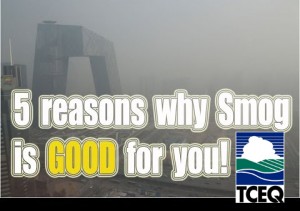 THE TCEQ RATIONALE FOR INACTION
THE TCEQ RATIONALE FOR INACTION
TCEQ says that a new federal gasoline mix with lower sulfur content will make car exhaust so much cleaner that no additional measures will be necessary to meet the new 75 ppb smog standard by the deadline of 2018. It says it's computer program tells it so. But that new mix won't be on the market until 2017, impacting only one summer out of three that'll be used by EPA to give us our running average. Even then, to reach the new goal of no more than 75 ppb of ozone by 2018, DFW smog levels would have to drop by double digits in just four years. That's never happened before. And many of us don't believe it has any chance of happening without reducing pollution from the gas industry, the Midlothian cement plants, and other large sources. We need to expose the TCEQ's junk science and make sure safe and legal air for six million people is more important than Rick Perry's presidential ambitions.
A CHANCE TO REDUCE POLLUTION FROM ALL SOURCES
The most successful air plan DFW ever had was in 2007, when coal plants, cement plants, vehicles and other sources of air pollution were addressed through new control measures.
That was the last time we had a comprehensive approach. And we almost met the 1997 85 ppb standard. This new plan offers an opportunity to do the same – if citizens can get organized. The DFW air plan is the "biggest fracking fight that isn't being fought" with a chance to seek region-wide pollution controls on the gas industry. It's a chance to bring state-of-the-art pollution controls to the Midlothian cement plants and East Texas coal plants. It's a chance to commit North Texas to more renewable energy, mass transit, and cleaner technologies of all kinds.
But first you have to show up.
Please come to the public strategy meeting this Sunday in Dallas to learn more about this clean air plan and what's being done to improve it.
Then on April 17th, come to the next official meeting of the DFW clean air plan in Arlington to listen and comment on discussions about local air quality.
These meetings are open to the public and public participation. Tell officials you want MORE pollution controls on ALL sources.
Don't Let Rick Perry continue to hold your lungs hostage.
The Biggest Fracking Fight That Isn’t Being Fought – DFW Air Plan Mtgs This Month
 Since fights over fracking began in the Barnett Shale, they've been mostly fights over specific permits, leases, or rules fought in one city at a time.
Since fights over fracking began in the Barnett Shale, they've been mostly fights over specific permits, leases, or rules fought in one city at a time.
Other than an occasional trip to Austin or DC to stop or support some piece of legislation, the action takes place in whatever community is putting up the most resistance. Front lines are fragmented and move around a lot. There's not a single cause that's united the energy from the multitude of ad hoc groups and individual "fracktivists" into a focused campaign for regional change. The closest thing to more encompassing battles have been the recent victories in Dallas and the current kickass campaign in Denton. These feel like old Cold War skirmishes – proxy clashes standing in for the on-going larger war over the Barnett Shale's soul.
But from now until the summer of 2015 there's a regional fracking fight waiting to be fought. It involves new bureaucracies and terms and mechanics, so it makes a lot of traditional fracking foes nervous. But the payoff is the potential to affect change throughout a 10-county area, including the heart of the urban Barnett Shale – Tarrant, Parker, Denton, Johnson, Wise and Ellis – as well as Dallas, Collin, Kaufman, and Rockwall.
What's the fight? It's over the new regional anti-smog plan, called a State Implementation Plan, or SIP. When a region hasn't met the federal standard for smog, also called ozone, it has to submit a plan to the EPA to explain how it's going to comply by the end of a three-year deadline. Despite at least three previous plans, DFW has never met the 1997 federal standard for smog. It's 85 ppb, or "parts per billion" concentration over 8 hours measured by approximately 20 stationary monitors scattered over the area. The closest we've come has been 86 ppb of ozone in 2009.
The new DFW plan is supposed to be designed to meet an even more ambitious target – no monitor higher than a three-year running average of 75 ppb of ambient air by 2018. We're at 87 ppb now. To reach the new goal, DFW would have to drop 12 parts per billion in ambient smog levels in four years -something that's never happened before.
Ozone/smog is created by a combination of Nitrogen Oxides (NOx) from combustion sources and Volatile Organic Compounds (VOCs) from combustion sources and evaporation sources mixing in daylight. The more sun, the more ozone.
What are combustion sources of NOx and VOCs? Power plants and cement kilns. Every boiler and furnace and oven. Every internal combustion engine. Every diesel engine. Anything with a flame or a spark.
What are evaporation sources of VOCs? Gasoline pumps,tanks and paint shops.
An anti-smog plan is supposed to look at all the sources of smog-forming pollution in a region and find the cheapest and easiest ways to reduce it. Past plans have been responsible for putting more controls on coal-fired power plants and the Midlothian cement plants, as well as creating HOV lanes and tightening inspection standards for vehicles. But one large category of smog-forming emissions has been left largely untouched by past air plans – the gas and oil industry.
It's not because gas and oil sources aren't capable of contributing to DFW smog. Start with all the trucks that are needed for each well and the NOx and VOC emissions they produce. Then the drilling rig itself. Some cities now require electric motors, others still allow diesel and the NOx and VOCs they produce. Think about all the chemicals being dumped into a well and then flowing back out, many of them VOCs. Flares are sources of both NOx and VOCs. Storage tanks and pipelines are huge sources of escaped evaporated VOCs. Diesel compressors are huge sources of NOx. There isn't a part of the oil and gas fuel cycle that doesn't produce smog-forming pollution.
It's not because the oil and gas emissions are insignificant. In 2011, the Texas Commission on Environmental Quality estimated that the VOCs being released by all the oil and gas facilities in the DFW area were greater than the volume of VOCs being released by all the cars and trucks on the road in the same region. In 2012, a Houston Area Research Council report estimated that a single flare or compressor could raise downwind ozone levels 3 to 5 parts per billion as far as five to ten miles away.
No, the oil and gas industry haven't been touched by these state anti-smog plans because the state doesn't want to impose new regional regulations on an industry. It's nothing personal. Austin doesn't want to impose new regulations on any industry. The last serious SIP was in 2007 – before the Barnett Shale boom and Rick Perry's presidential campaign. Since then, it's been one excuse after another from TCEQ about why no new controls are necessary – even though DFW air quality progress has stopped and we're still in violation of a 20-year old smog standard.
It's also true that the oil and gas industry hasn't been touched by an air plan because no one's made them. No DFW anti-smog plan has been the focus of a fracking campaign like the recent Dallas Trinity East permits, or the Denton petition drive. There been no pressure on state government to respond to a regional demand for action.
But the new DFW air plan does offer gas activists a chance to get reforms outside of their own city limits. For example, it could be the goal to include mandatory electrification of compressors in this plan. It's been estimated that 60 % or more of the air pollution from the gas fuel cycle comes from compressors. Electrification doesn't solve all their air pollution problems but it takes a huge bite out of them because the compressors are no longer being run by locomotive size diesel engines. Electrification of new compressors and a phase-in to replace existing diesel engines could reduce not just smog pollution, but toxic air pollution and greenhouse gases by thousands of tons a year.
Even if Austin rejects such proposals, there's a part of every plan called the "Weight of Evidence" category that's more inclusive to voluntary measures. A recommendation for cities and counties to demand electrification of all compressors in the DFW region isn't as immediate as a state-sponsored mandate, but it's an official good housekeeping seal you can take to local city councils and pass one by one until it does become a de facto regional policy. This is exactly what happened with Downwinders' Green Cement procurement campaign from 2007-2011 aimed at getting rid of old wet cement kilns in Midlothian. A short recommendation to local governments about where to buy their cement in the 2007 SIP was turned into a model ordinance by Dallas and then passed by a dozen other entities, one by one, over the next two years. by the end of this year, there will be no wet kilns lift in Midlothian.
The same thing could happen with compressors in this new plan, or green completions, or tanks, or pipelines in this new DFW air plan – if activists are willing to invest the same amount of time and energy into a regional fight as they do in their own backyard battles.
You have a couple of chances in April to dip your toes into the SIP Process. This coming Sunday, April 6th, from 3 to 5 pm at the Texas Campaign for the Environment office in Dallas, State Rep Lon Burnam and Downwinders at Risk will be hosting a strategy meeting for folks who want to know more about how to take advantage of this new air plan. Central to this strategy is involving more gas activists to win a regional fight, so y'all come.
Then on April 17th, at 10 am at the North Central Council of Governments Headquarters in Arlington, there's a meeting of the SIP "technical committee" that will be hearing presentations from the state and others about DFW's smog problem. Don't let the "technical committee" name fool you. These are open to the public and anyone can attend. In fact, this is your chance to ask questions of the state and the experts.
And to make it more interesting, we think we've managed to convince the Powers That Be to include UNT graduate student Mahdi Ahmadi's presentation on Barnett Shale contributions to DFW ozone as part of the April 17th meeting. This was the study recently featured by Peggy Heinkel-Wolfe in the Denton Record Chronicle:
According to the results, the air monitoring sites surrounded by oil and gas production activities, generally on the west side of DFW, show worse long-term trends in ozone reduction than those located farther from wells on the east side of DFW.
His spatial analysis of the data showed that ozone distribution has been disproportionally changed and appears linked to production activities, perhaps an explanation why residents on the western side of DFW are seeing more locally produced ozone, particularly since 2008.
If this one fails, another new air plan will not be due until at least 2019 or 2020 at the earliest. This is our only chance until then to affect the gas industry over a wide area instead of just one permit or one city at a time. Let's try to make it count.
DFW Anti-Smog Plan Strategy Meeting
Sunday April 6th 2-5 pm
Texas Campaign for the Environment Offices –
3303 Lee Parkway #402 • Dallas, TX 75219 – across from Lee Park
Hosted by St. Rep. Lon Burnam and Downwinders at Risk
DFW Air Plan Committee Meeting – open to the public
10 am to 12 noon
Thursday April 17th
North Central Texas Council of Governments
616 Six Flags Drive, Arlington – across the street from the amusement park
Another Chapter of “Why Don’t We See This in Midlothian?”
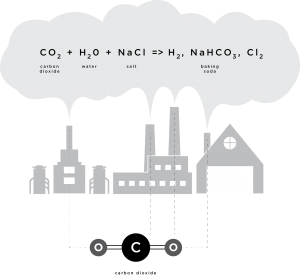 Cement plants are among the world's largest sources of CO2. In order to reduce their carbon footprints, either voluntarily or to comply with new environmental regulations, as well as make a buck, owners are trying out different strategies to turn their Greenhouse Gases into just plain green cash.
Cement plants are among the world's largest sources of CO2. In order to reduce their carbon footprints, either voluntarily or to comply with new environmental regulations, as well as make a buck, owners are trying out different strategies to turn their Greenhouse Gases into just plain green cash.
As far as we can tell, the "SkyMine" pilot-project announced for San Antonio's Capital Aggregates Cement Plant is still on schedule for operation later this year. Employing 50 people, the first-of-its-kind facility will convert the cement plant's carbon dioxide into baking soda and hydrochloric acid that's aimed at oil and gas field use.
Now comes word that a LaFarge Cement Plant in Canada is hooking up with a fuel cell company to make a slightly more progressive product from its GHGs:
"Mantra Energy Alternatives has struck a deal with Lafarge Canada to deploy an electrochemical reduction technology at Lafarge’s No. 9 Road cement plant.
“This will be the first pilot plant of its kind in the world,” said Mantra’s vice-president Patrick Dodd in a press release.
On paper, the technology would convert carbon dioxide, considered the most prolific greenhouse gas, into useful chemicals like formic acid and formate salts. The pilot plant would convert 100 kilograms per day of carbon dioxide emitted from the local cement plant into concentrated formate salts, which sell for about $1,500 per tonne.
Mantra is eying the formic acid for use in its patented fuel cells, which it bills as a significantly less expensive fuel cell with greater power density."
Granted, the manufacturing of oil and gas chemicals sounds more likely for one of the three huge Midlothian cement plants to attempt than diving into the alternative energy business, but at least it's something. The end products can change and adapt but these projects begin to put the infrastructure of a supply and demand system in place while seeing potentially large decreases in CO2 output. In 2014 America, the fastest way to get reductions in GHGs is to make it profitable to do so. These experiments pave the way for that to happen.
There's no question that the TX/ Martin-Marietta, Holcim and Ash Grove cement plants are the largest stationary sources of CO2 in North Texas, or that together, they form a huge GHG hotspot. All the old coal-fired power plants that would have challenged them have been shuddered or converted to gas.
While (forced) modernization at all three plants like the conversion from wet to dry kiln technology has brought all emission totals down, particularly CO2, the fact remains that the huge scale of operations in Midlothian means there's no other facilities that churn it out as much. And yet not one creative idea for how to reduce those huge local emissions has been announced from any of those companies. You can't just use the Texas excuse because the San Antonio experiment is happening despite no immediate government mandate, especially on existing facilities. And you might think that the first company to do so would receive some needed good PR. But nope.
This has been another chapter of "Why Don't We See This in Midlothian?"
A Barnett Shale Manifesto…From Austin
 Sometimes it takes a perspective above the grind of trench warfare to give you a better sense of what the entire battlefield looks like. That's what UT Law Professor Rachel Rawlins has done for Barnett Shale activists with the recent publication of her article "Planning for Fracking on the Barnett Shale: Urban Air Pollution, Improving Health Based Regulation, and the Role of Local Governments" in the new Virginia Environmental Law Review.
Sometimes it takes a perspective above the grind of trench warfare to give you a better sense of what the entire battlefield looks like. That's what UT Law Professor Rachel Rawlins has done for Barnett Shale activists with the recent publication of her article "Planning for Fracking on the Barnett Shale: Urban Air Pollution, Improving Health Based Regulation, and the Role of Local Governments" in the new Virginia Environmental Law Review.
Don't let the academic title fool you. This is a call for a radically new approach to how communities in Texas regulate the risks of fracking, and every other type of heavy industry. We put the link up for the piece on our Facebook page on Saturday based on a quick reading of its commentary on the Flower Mound cancer cluster, but it's more, so much more than that. Among other things, it's a comprehensive rebuttal of every claim of safety and well-being ever issued by the industry or state authorities about the health of residents living in the Barnett Shale, of which the Flower Mound case is only one example. Rawlins has produced a one-stop catalog of each major air pollution health controversy in the Barnett since concerns began to grow in the last decade, with an almost 30-page review of why no industry or government-sponsored study of fracking pollution and its health effects is a satisfactory response to those concerns. Want to convince your local officials that fracking isn't as safe as it's touted? Here's the staggering blow-by-blow commentary to do it.
But all of that documentation is presented in service to making the point that current state and federal regulation of fracking is failing to protect public health, both in design and in practice. Professor Rawlins' solution to this problem is not to give the state and federal government more power to regulate the gas industry. No, it's to turn the current regulatory framework upside down and give more power to local governments to do the things that the state and federal government should be doing.
In making this recommendation, she echoes the strategy that's been driving Downwinders since it was founded – that the best way to regulate pollution problems is at the local level where the most harm is being done, and it should be directed by the people being harmed. This is what drove our Green Cement campaign that closed the last obsolete wet cement kiln in Texas. This is what fueled our campaign to close down the trailer park-come-lead smelter in Frisco. And it's what was behind the recent Dallas fights over drilling. In each case, it wasn't Austin or Washington DC that was the instrument of change – it was local governments, pressed by their constituents, flexing their regulatory powers. The same thing is driving activists in Denton who are organizing the ban fracking petition drive and vote.
This strategy avoids battles where industry is strongest – in the halls of the state capitol and in DC, where citizens are outspent millions to one. Instead, it takes the fight to neighborhoods where the harm is being done or proposed, where people have the most to lose, where the heat that can be applied to elected officials is more intense. Citizens will still get outspent, but the money doesn't seem to buy corporations as much influence among those actually breathing the fumes of the drilling site, or smokestack.
Particularly now, with corporate-friendly faux-Tea Party types in control of state government and the House of Representatives in DC, there is little room for grassroots campaigns to make a difference by passing new legislation. Even if by some miracle a few bills did pass, their enforcement would be up to the same state or federal agencies that are currently failing citizens. Local is more direct, and more accountable. Professor Rawlins agrees, and spends most of the rest of her 81-page journal article citing the ways in which local control of fracking in the Barnett Shale is hampered by the out-dated top-down approach to regulation, and what should be done to fix that.
Included in her recommendations are two long-term Downwinders projects: Allowing local governments to close the "off-sets" loophole for the gas industry that exempts them from having to compensate for their smog-forming pollution in already smoggy areas like DFW, and creating California-like local air pollution control districts that could set their own health based exposure standards and pollution control measures without having to go through Austin or DC.
If there's a single major fault in Rawlins's analysis, it's that she believes more local control of pollution risks is itself dependent on action by an unwilling state government. But Downwinders and others have shown that isn't true. Our most significant and far-reaching victories – from the closing of the Midlothian wet kilns to the new Dallas drilling ordinance – have all taken place while Rick Perry was Governor and the state legislature was in the hands of our opponents. We did these things despite Austin, not because we had its permission. Local zoning laws, local permitting rules, local nuisance acts, and other local powers are under-utilized by both residents and their elected officials when it comes to pollution hazards.
The same is true now of Downwinders' off-sets campaign aimed at the gas industry. We think we've found a way to avoid the "preemption" argument that would keep local governments from acting on smog pollution from gas sources by aiming the off-sets at Greenhouse gases – an area of regulation Texas is loathe to enter. By targeting GHG reduction, we also reduce a lot of toxic and smog-forming air pollution. It's a back door way, but it accomplishes the same goal. It's going to be up to Texas activists to sew similar small threads of change through an otherwise hostile political environment.
Even given that flaw, Professor Rawlins' introduction to her article is the most concise summary of the air pollution problems caused by gas mining and production in the Barnett, as well as the most credible call to action for a new way of doing business there. Here it is reprinted in full for your consideration:
In the last decade hydraulic fracturing for natural gas has exploded on the Barnett Shale in Texas. The region is now home to the most intensive hydraulic fracking and gas production activities ever undertaken in densely urbanized areas. Faced with minimal state and federal regulation, Texas cities are on the front line in the effort to figure out how best to balance industry, land use, and environmental concerns. Local governments in Texas, however, do not currently have the regulatory authority, capacity, or the information required to closet he regulatory gap. Using the community experience on the Barnett Shale as a case study, this article focuses on the legal and regulatory framework governing air emissions and proposes changes to the current regulatory structure.
Under both the state and federal programs, the regulation of hazardous air emissions from gas operations is based largely on questions of cost and available technology. There is no comprehensive cumulative risk assessment to consider the potential impact to public health in urban areas. Drilling operations are being conducted in residential areas. Residents living in close proximity to gas operations on the Barnett Shale have voiced serious concerns for their health, which have yet to be comprehensively evaluated. Given the complexityof the science, and the dearth of clear, transparent, and enforceable standards, inadequate studies and limited statistical analysis have been allowed to provide potentially false assurances. The politically expedient bottom line dominates with little attention paid to the quality of the science or the adequacy of the standards.
Determining and applying comprehensive health-based standards for hazardous air pollutants has been largely abandoned at the federal level given uncertainties in the science, difficulties of determining and
measuring “safe” levels of toxic pollutants, and the potential for economic disruption. Neither the state nor the federal government has set enforceable ambient standards for hazardous air pollutants.Identifying cumulative air pollution problems that may occur in urban areas, the State of California has called upon local governments to identify “hot spots” and to consider air quality issues in their planning and zoning actions. In Texas, however, preemption discussions dominate the analysis. Any local government regulation that might provide protection from toxic air emissions otherwise regulated by the State must be justified by some other public purpose.
Texas should consider authorizing and encouraging local level air quality planning for industrial activities, similar to what California has done. Care should be taken to separate these facilities from sensitive receptors and “hot spots” that may already be burdened with excessive hazardous air emissions. Given the difficulty of the task, there is also an important role for the state and federal governments in working to establish ambient standards for hazardous air pollutants, as well as standards for health based assessment and public communication. The uncertainty inherent in any of these standards should be made clear and accessible to local governments so that it may be considered in making appropriate and protective land use decisions. Texas should consider allowing local governments to have the power to establish ambient air quality standards, emissions limitations, monitoring, reporting, and offsets for hazardous air pollutants, following the model applied to conventional air pollutants pursuant to the federal program.
Professor Rawlins' article provides Barnett Shale activists with a new map to guide them toward more effective action. We'd all do well to study it and pick local battles that promise to contribute toward its realization.
Can You Spot the Mistake in This Map?
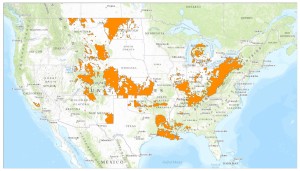 Here's why there's a missing big orange splotch….or two….or three, in Texas in this new national map of oil and gas well concentration.
Here's why there's a missing big orange splotch….or two….or three, in Texas in this new national map of oil and gas well concentration.
New UNT Study-In-Progress Links Gas Pollution to Persistent DFW Smog
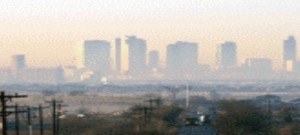 This is why it's important for citizens to have real scientific horsepower.
This is why it's important for citizens to have real scientific horsepower.
DFW has a smog problem. It's not as bad as it used to be, but it's still at unsafe and illegal levels. And for the last four or five years, the air quality progress that should have been made has been stymied. Despite almost all large sources of smog-producing pollution being reduced in volume, our running average for ozone is actually a part per billion higher than it was in 2009.
Many local activists believe this lack of progress is due to the huge volumes of smog-producing air pollution being generated by the thousands of individual natural gas sites throughout the DFW region itself, as well as upwind gas and oil plays. In 2012, a Houston-based think tank released a report showing how a single gas flare or compressor could significantly impact downwind smog levels for up to 5 mile or more. Industry and the Texas Commission on Environmental Quality say no, gas sources are not significant contributors to DFW smog. In fact, during this current round of planning, the state has gone out of its way to downplay the impact of gas pollution, including rolling back previous emission inventories and inventing new ways to estimates emissions from large facilities like compressor stations.
Into this debate steps a UNT graduate student offering a simple and eloquent scientific analysis that uses the state's own data on smog to indict the gas industry for its chronic persistence in DFW – especially in the western part of he Metromess, where Barnett Shale production is concentrated.
On Monday night Denton Record-Chronicle reporter Peggy Heinkel-Wolfe gave a summary of a presentation on local air quality she'd sat through that day at UNT:
"Graduate student Mahdi Ahmadi, working with his advisor, Dr. Kuruvilla John, downloaded the ozone air monitoring data from the Texas Commission on Environmental Quality back to 1997, a total of more than 6.5 million data points, he said, and has been studying it for the past four months.
Ahmadi wanted to explore a basic question underlying a graphic frequently distributed by the TCEQ that shows gas wells going up in DFW as ozone goes down, which suggests in a not-very-scientific-at-all way, that the increasing number of gas wells is having no effect on the ozone.
Ahmadi adjusted for meteorological conditions to determine how much ozone DFW people are making and where. Such adjustments have been explored by others to understand better the parts of ozone-making we can control, because we can’t control the weather. He used an advanced statistical method on the data, called the Kolmogorov-Zurbenko filter, to separate the effects of atmospheric parameters from human activities.
According to the results, the air monitoring sites surrounded by oil and gas production activities, generally on the west side of DFW, show worse long-term trends in ozone reduction than those located farther from wells on the east side of DFW.
His spatial analysis of the data showed that ozone distribution has been disproportionally changed and appears linked to production activities, perhaps an explanation why residents on the western side of DFW are seeing more locally produced ozone, particularly since 2008.
Ahmadi's results are not definitive, and the paper he's writing is still a work-in-progress. But he's asking the right questions, and challenging the right unproven assumptions. He's at least put forth an hypothesis and is trying to prove or disprove it. He's using science. TCEQ's approach is all faith-based.
Anything that takes the focus off vehicle pollution is anathema to Austin and many local officials who want to pretend that industrial sources of air pollution don't impact the DFW region enough to make a difference so they don't have to regulate them. If there's a guiding principle to TCEQ's approach to this new clean air plan, due in July 2015, it's to avoid any excuse for new regulations while Rick Perry is running for President. The agency isn't interested in doing any kind of science that might challenge that perspective – no matter how persuasive. After all, you're talking about a group that doesn't believe smog is bad for you. TCEQ doesn't want to know the truth. It can't handle the truth. It's got an ideology and it's stickin' to it.
So it's up to young lowly graduate students from state universities armed only with a healthy sense of scientific curiosity to step up and start suggesting that the Emperor's computer model has no clothes, and offering up alternative scenarios to explain why DFW air quality is stuck in neutral. It turns out, just doing straight-up classroom science is enough to threaten the fragile House of Computer Cards with which the state's air plan is being built.
Perhaps equally as ominous for the success fo any new clean air plan is Ahmadi's discovery that ozone levels in DFW have been during the winter time, or "off-ozone-season." There could be a new normal, higher background level of smog affecting public health almost year round.
Mahdi Ahmadi's study is just one of the many that need to be done to construct an honest clean air plan for DFW, but it shows you what a curious mind and some computing power can do. Citizens can't trust the state to do the basic science necessary as long as the current cast of characters is running the show in Austin. EPA won't step in and stop the farce as long as TCEQ can make things work out on paper. If the scientific method is going to get used to build a better DFW clean air plan, it's going to have to be citizens who apply it.
What are the Pollution Impacts of the New Liquified Natural Gas Plant Announced for Midlothian?
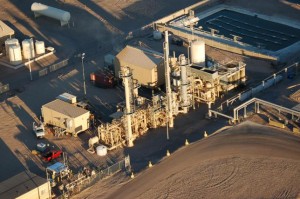 If you're already hosting the three or four largest single sources of air pollution in the entire region you need new large industrial sources of crap like a hole in the head. Likewise, if you've already violated the Clean Air Act for decades the last thing you need are new large sources of smog-producing pollution. But that's exactly what's happening with the announcement last week that a new Liquified Natural Gas (LNG) plant is being proposed for Midlothian's Railport Industrial Park, located between Midlothian and Venus on Highway 67, directly below, and upwind, of the Dallas-Tarrant County line.
If you're already hosting the three or four largest single sources of air pollution in the entire region you need new large industrial sources of crap like a hole in the head. Likewise, if you've already violated the Clean Air Act for decades the last thing you need are new large sources of smog-producing pollution. But that's exactly what's happening with the announcement last week that a new Liquified Natural Gas (LNG) plant is being proposed for Midlothian's Railport Industrial Park, located between Midlothian and Venus on Highway 67, directly below, and upwind, of the Dallas-Tarrant County line.
Applied Natural Gas Fuels (ANGF) put out a press release on March 21st that touted the purchase of 31 acres for a facility that would house "five liquefaction units, each able to produce 86,000 gallons of fuel daily, and total onsite storage of 1.5 million LNG gallons."
"In preparation of building the facility, which was announced last September, ANGF has purchase orders for all long-lead time items, such as storage tanks, production skids and electric motors and compressors, the company said.
The plant seeks to supply both road transportation and other off-road high-horsepower applications, such as rail, marine, mining, remote power generation and oilfield exploration/production (E&P) operations."
LNG plants take natural gas and cool it to minus 260 degrees F, at which point it becomes a liquid. This allows the industry to be able to store and move it compactly. It's been described as reducing the air out of a beach ball to shrink it to the size of a ping pong ball. But it also greatly increases the chances of accidents. If there's a leak or spill from a tank or pipeline the LNG would convert back to a gas. As it diluted with air, the natural gas/air mixture could become potentially explosive if the concentration of natural gas in air reached between 4% and 17%. In this range, any source of ignition (cell phone, cigarette lighter, attic fan, light switch, auto or boat engine spark plug, carpet spark, etc.) could ignite a vapor cloud and impact a large area.
ANGF already operates an LNG plant in Topock, Arizona, only three miles on the other side of California's border – and tougher regulations. At the same time it's building its new facility in Texas, the company is also doubling the capacity of the Arizona plant. According to an online document about the company's current operations from the Southern California Air Pollution Control District,
"…the gas must be stripped of impurities until it's over 98% methane. Co2, H2S, other sulfur components, moisture, mercury, and particles are stripped via acid gas removal and disposal, gas dehydration, mercury removal, and particle filtration…. The emissions associated with these processes include CO, VOC, SOx, NOx, H2S, particulates, and many toxic organic compounds."
That's Carbon Monoxide, a poison everyone's familiar with, Volatile Organic Compounds, a smog-producing class of chemicals like Benzene and Toluene, many of which are also carcinogenic, Sulfur Dioxide, a respiratory irritant which also causes acid rain, Nitrogen Oxide, a smog-producing respiratory irritant, PM pollution that's been linked to everything from heart attacks to Parkinson's, Mercury, a notorious neurotoxin, and oh yes, Hydrogen Sulfide, or "sour gas," a highly toxic and flammable poison that causes pulmonary edema at low concentrations and death at high ones.
We don't have specific annual volumes of those pollutants for the Midlothian plant yet, and may never get them if the facility receives a standard permit with only an upper ceiling of emissions, but LNG plants use a lot of energy, and therefore have the potential to emit a lot of air pollution. It appears that the Midlothian plant will be burning natural gas for its power, including huge gas turbine compressors. At much larger LNG export plants proposed for the coasts, these compressors have been the subject of a lot of concern. Last November, a Canadian wildlife conservation group released a report on a string of proposed LNG plants for British Columbia that estimated the facilities would be burning most of the gas used in the Province,
"The report, Air Advisory: The Air Quality Impacts of Liquefied Natural Gas Operations Proposed for Kitimat, B.C., concluded LNG plants permitted to operate primarily with natural gas will collectively burn 60 per cent of all the natural gas burned annually in B.C.
The report concluded nitrogen oxide emissions from the LNG plants would increase 500 per cent above existing levels. Nitrogen oxide emissions create acid rain, which harms waterways and fish and creates smog, which causes respiratory problems for children and the elderly, the report states.
The report also concluded natural gas driven LNG plants will increase emissions in the Kitimat area of volatile organic compounds, carbon monoxide and sulphur dioxide."
As a result of these kinds of concerns, the Canadian government committed to spending over a half million dollars on a study of how the gas industry will affect air quality in this part of British Columbia.
The Midlothian plant will be much smaller, put its impact on local and regional air quality could still be substantial depending on the design and technology. Industrial Hydrogen Sulfide and VOCs are not something you want wafting into your backyard, and anything that makes more smog is bad news for the entire DFW region.
Locating in Railport – itself a piece of heavy-metal contaminated ranch property bought and developed by TXI to prevent further liability issues – the LNG plant adds to the inventory of polluters that call Midlothian home. Three large cement plants, a steel mill, a gas power plant, and other smaller entities have made sure the city is the closest thing to a DFW Ship Channel that we have. Collectively, these facilities emit a kind of super plume of air pollution that spews north into the middle of the Metromess during most of the year. If you live anywhere from SW Dallas to NW Tarrant County, you're already breathing the pollution from Midlothian industry. How much the ANGF facility will add to that plume is not yet known, but any increase is going in the wrong direction. Stay tuned.
CDC: Vehicle Exhaust Linked to Higher Child Leukemia Near Roads
 After a review of over 30 years of studies, the Centers for Disease Control concluded that children living near high-volume roads and highways were 50% more likely to suffer from childhood leukemia. The cancer risk is linked to postnatal exposure.
After a review of over 30 years of studies, the Centers for Disease Control concluded that children living near high-volume roads and highways were 50% more likely to suffer from childhood leukemia. The cancer risk is linked to postnatal exposure.
In the April issue of the American Journal of Preventative Medicine, researchers for the CDC explain how they examined all the published studies concerning traffic air pollution risks from 1980 to July of 201. Out of nine relevant studies, seven, covering approximately 8,000 children, reveled a correlation between exposure and leukemia.
"The review found that children diagnosed with leukemia were "50% more likely to live near busy roads than children without leukemia," said Vickie Boothe, a CDC health scientist and lead author of the Journal article. "While the study found a link, it does not prove that living near a busy road causes leukemia."
Previous studies have linked proximity to road traffic with higher childhood asthma and autism rates.
Planning Your Social Change
 Over the last couple of months, the victory by residents to impose a "de facto ban" on fracking in Dallas has been invoked as a rallying cry by citizens in a number of different places. From Denton, to Mansfield, to Los Angeles, to Move On, the fact that JR's hometown has made it difficult to drill with impunity is seen as a significant blow to the relentless rolling wave of rigs, tanks and pipes that's transformed DFW into an urban gas field over the past decade. It's given aid and comfort to those trying to face down the gas industry elsewhere, and provided a more progressive model of regulation.
Over the last couple of months, the victory by residents to impose a "de facto ban" on fracking in Dallas has been invoked as a rallying cry by citizens in a number of different places. From Denton, to Mansfield, to Los Angeles, to Move On, the fact that JR's hometown has made it difficult to drill with impunity is seen as a significant blow to the relentless rolling wave of rigs, tanks and pipes that's transformed DFW into an urban gas field over the past decade. It's given aid and comfort to those trying to face down the gas industry elsewhere, and provided a more progressive model of regulation.
That isn't a happy accident of a local NIMBY fight. It's by design. Four years ago, it was the intent of Dallas organizers to make it so, and it was absolutely essential to Downwinders that the Dallas fight be a strategic one, that it have reverberations far beyond the city's limits.
In 2010, Downwinders had to justify why it wanted to take on fracking in Dallas. The group had just transformed itself from one concerned mostly with local cement plant air pollution to one taking up the cause of the entire DFW airshed. If we were jumping into the fracking controversy for the first time, where would we land? Why Dallas and not someplace else? How could we be sure our investment of scarce organizational resources would benefit clean air and environmental health more in this fight than others?
The Timing: Dallas was the last city in the Barnett to actually process gas well permits. It still hadn't done so in 2010 when the City Plan Commission was gearing up for its first "Special Use Permit" hearings. Despite most of the western side of the Metromess already being inundated by industry, fracking was a fresh fight over a new kind of industrial activity that Dallas hadn't hosted. Any one who's done this before will tell you it's always easier to stop something new than after it already starts. They'll also tell you that when you have a choice, don't engage the opposition on their own turf. Try to play on your own field or at least a neutral one. Dallas offered the last and best chance in the Barnett to fight fracking as a new thing on a neutral field.
The Issue: Because the exemptions fracking needed to operate in urban areas only became reality in the 2005 Energy Bill, examination of its external environmental costs took a while to, er, surface. But research was finally beginning to catch up to the facts. In 2009, Downwinders' consultant, SMU Professor, and future EPA Regional Administrator Al Armendariz's landmark report for EDF on smog pollution from the gas industry was the information that made many of us sit up and take notice of fracking as a threat to regional air quality. Through its leadership in the cement plant wars, Downwinders had worked its way into the DFW air quality planning process. We knew smog. We didn't know gas mining made smog much worse – and neither did anyone else – until Al's report. His work demonstrated why drilling in North Texas would make it harder for the area to quit violating the Clean Air Act. As a group that had just changed its mission to protect North Texas air quality, this was information hard to ignore. Suddenly the fight against urban fracking in Dallas was a new front in an old war.
The Politics: Dallas had been an ally of Downwinders in the cement wars, passing the first "green cement" procurement ordinance in the nation in 2007. Mayor Laura Miller lead the fight against Rick Perry's rush to permit over a dozen new dirty coal plants. It was a leader among local municipalities in addressing climate change and actually had an annual goal of reducing its carbon footprint as a city. It paid lip service to the language of "sustainability." Dallas was traditionally more progressive than other city governments on environmental issues (don't laugh). We could use all of this past action and rhetoric – especially on smog – to press our case in Big D in a way that no other local government allowed, because it had the record of concern. Always use your opponent's language against them if you can. From an environmental point of view, if you couldn't get green-friendly Dallas to pass a better, more modern drilling policy, you were going to have a hard time doing it any place else in the Barnett.
At the same time, the then-current city council was seeing the rise of a new generation of Dallas political leadership through Angela Hunt sparring with the old establishment. One of her issues was gas drilling in Dallas. Organizers already had a friend on the horseshoe.
The Stage: Much to the chagrin of Fort Worth, Arlington and other North Texas cities, Dallas is the flagship for the region. It's still the region's largest municipality. It's still the region's media center. It's home to the Cowboys, and JR, and the Triple Underpass. Things that happen in Dallas tend to get more coverage than they would if they were taking place in, say, Mesquite, or Burleson. Politics is under more of a microscope. There are still reporters assigned to cover nothing but City Hall goins-on. There were plenty of gas permit fights in play in 2010. But only those in Dallas promised to provide the kind of oversized stage with the potential for blow-by-blow reporting of the battle that would transform the permit fights into the Dallas Gas Wars.
The Definition of Winning: You don't hear anybody going around boasting about how hard residents fought before they lost the fight to completely ban fracking in Dallas out right. But that would have been the result had residents listened to the most strident voices among their ranks. There were calls for a direct up or down vote on fracking in Dallas, and for residents to settle for nothing less than a complete ban. That result was politically impossible with the City Council in office in 2010. It was still impossible in December of 2013 when the council cast its 9-6 vote for the "de facto ban" ordinance (and after a majority voted in favor of the Trinity East permits in August).
Believe it or not, there are still those hardy resisters who think the December ordinance vote is a huge defeat and allows for rampant drilling in Dallas . Fortunately, most everyone else, including and the industry itself, sees the new ordinance for what it is – a very high bar for the pursuit of fracking in Dallas that's unlikely to be met any time soon, if ever, given the nature of operators to seek the path of least resistance.
For Downwinders, and most of the residents involved, it was better to win the war on the ground and lose the semantics battle, rather than fight the good fight with the politically-correct language and lose the war.
You have to pick your battles carefully.
Not many people know the story of Claudette Colvin. Nine months before Rosa Parks made headlines and began the Birmingham Bus Boycott that would initiate the modern civil rights movement, Ms. Colvin was arrested for violating the same segregationist law against black folk riding in the front of a Birmingham city bus. It was a righteous battle, but she was a high school student and an unwed mother. She wasn't considered the right test case for a national fight all the way to the Supreme Court, where public opinion would be crucial to winning. Instead, the NAACP picked one of its own. The matronly Parks was the chapter's local secretary and considered a more sympathetic figure. They were right.
Would the Court have ruled the same for a Claudette Colvin? Nobody knows, but the strategic thinking of segregation's opponents made sure the best circumstances were in place for significant change to happen. That's all an organizer can do. But it's something that must get done in order for victories like the Dallas ordinance to have the kind of disproportional reverberations it's having now.

